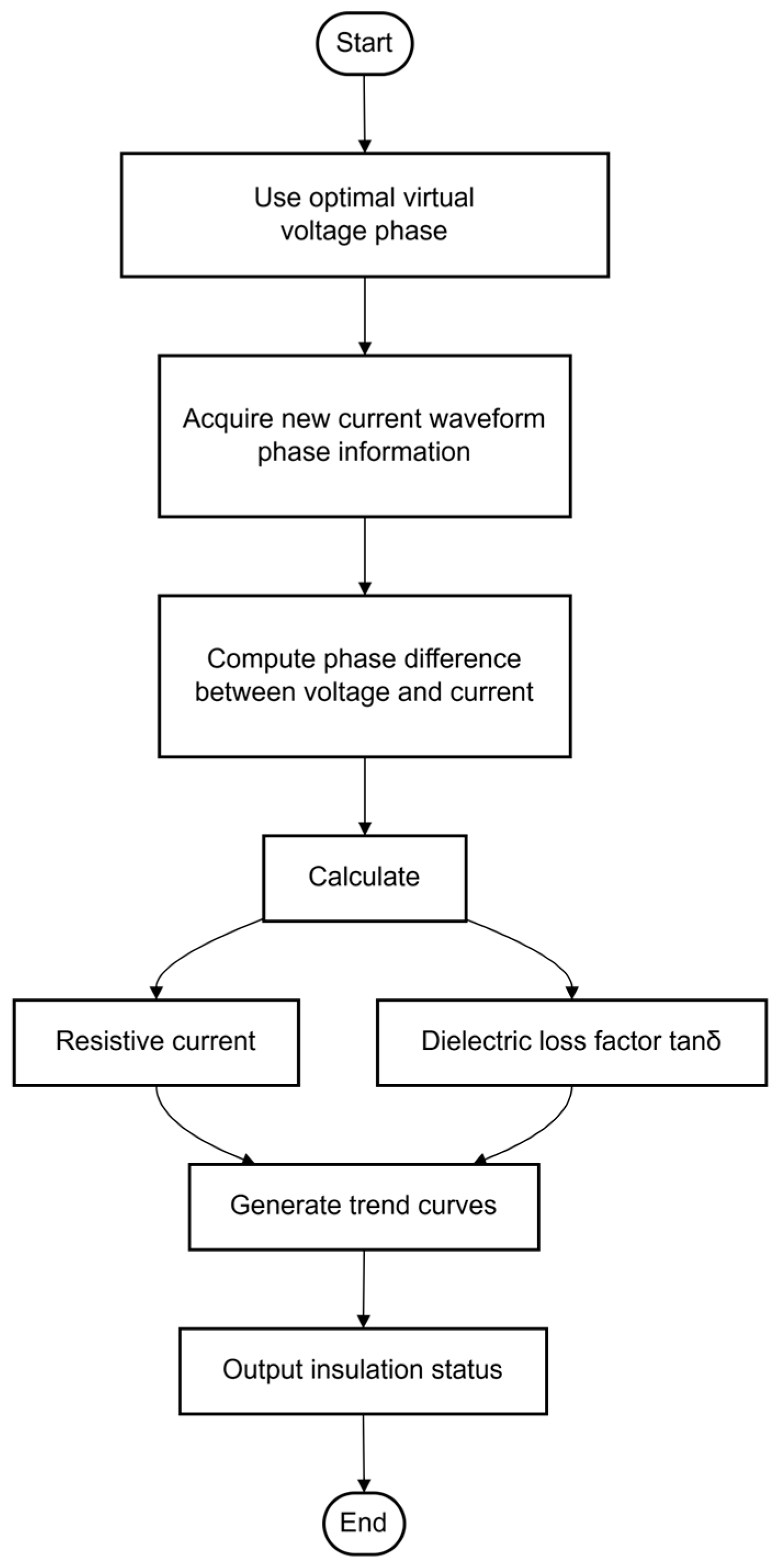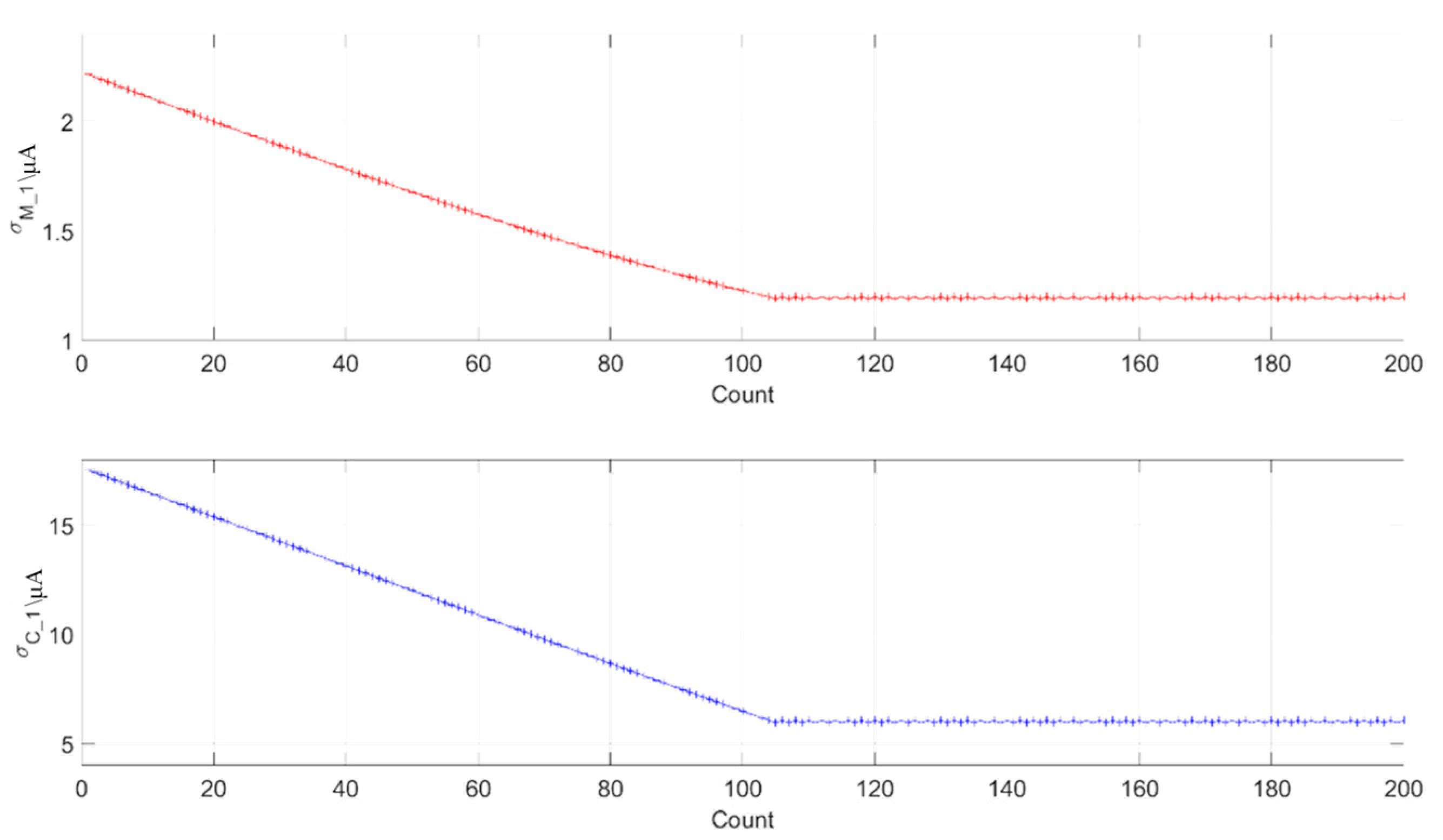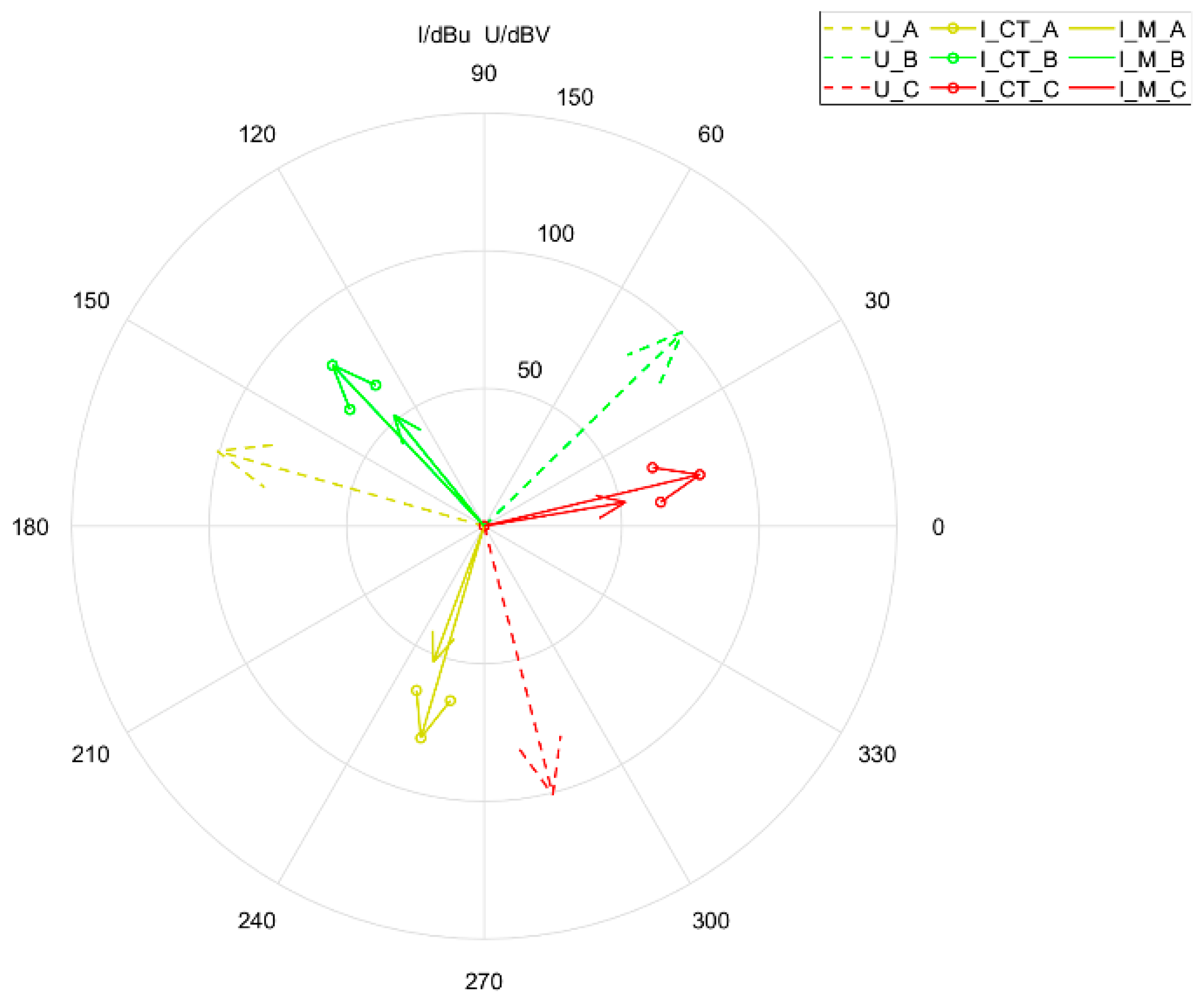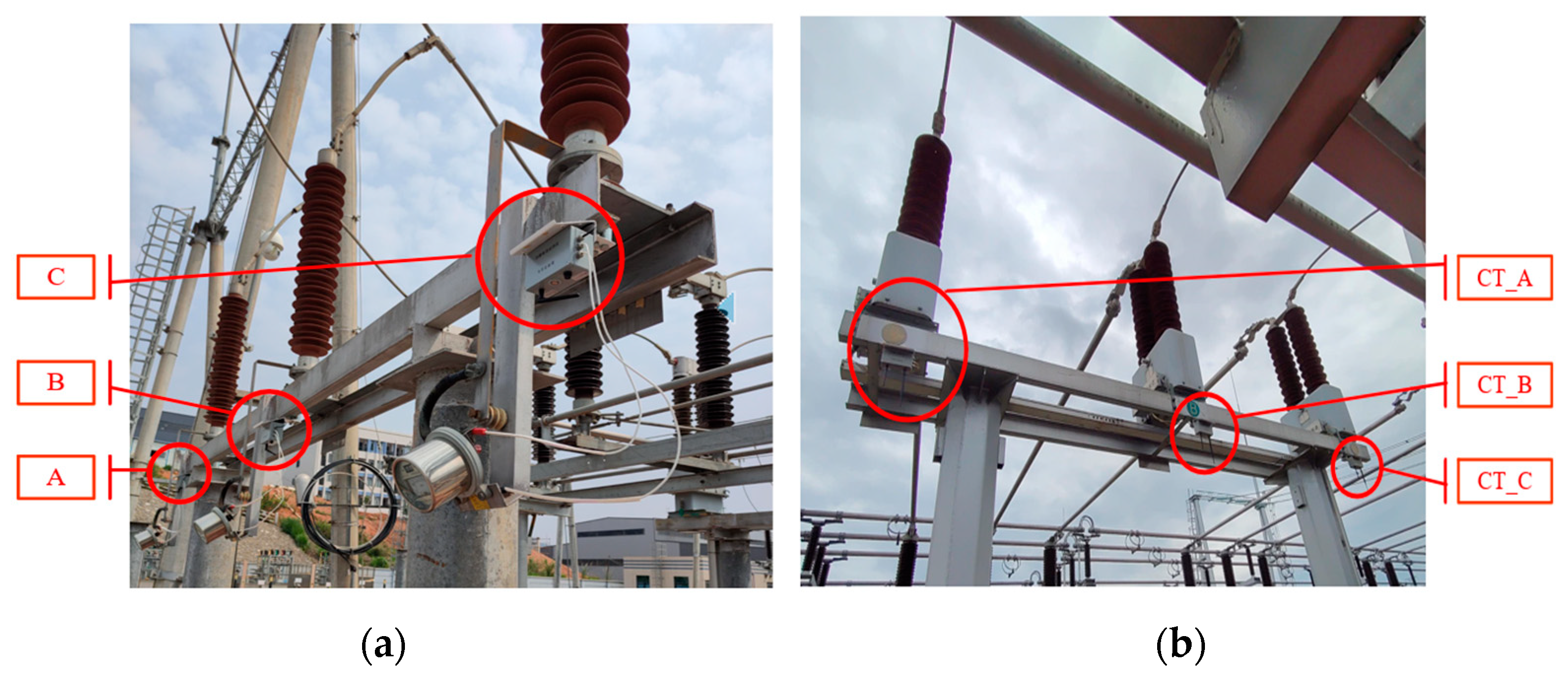Insulation Online Monitoring Method for Dry-Type Current Transformers Based on Virtual Voltage
Abstract
1. Introduction
2. Materials and Methods
2.1. The Overall Idea of the Online Monitoring Method
2.2. Virtual Voltage Solution
2.2.1. Phase Constraint Relationship Modeling
- , Measured quantities (the fundamental current phase of the arrester/dry-type CT for phase P).
- ,: Initial estimates (converted from the dielectric loss angle / via 90° − δ).
- ,: Intermediate quantities (the initial virtual voltage phase estimates derived from the arrester/dry-type CT).
- : Target quantity (the common virtual voltage reference phase for phase P, solved via phase constraints).
2.2.2. LMS Iterative Algorithm
- ,: Measured quantities (the fundamental current amplitudes of the arrester (M) and dry-type CT (C) for phase P).
- ,: Intermediate quantities (the initial resistive currents derived from the measured amplitudes and initial phase differences).
- , : Target quantities (the theoretical phase differences derived directly from the dielectric loss angles /).
- , : Target quantities (the theoretical resistive currents calculated using /).
- , : Intermediate quantities (the deviations between the initial and theoretical resistive currents for phase P).
2.3. Calculation of Insulation Online Monitoring Parameters
- (1)
- The optimal three-phase virtual voltage reference phase is obtained in the first stage of the operation.
- (2)
- Utilizing the optimal three-phase virtual voltage reference phase and the phase information , of the full current fundamental wave of the three-phase arrester and dry-type CT obtained from subsequent group measurements, the phase difference sequence , between the full current fundamental wave and the voltage fundamental wave is calculated in real time.
- (3)
- By using the amplitudes , of the fundamental wave of the three-phase arrester and dry-type CT full current obtained through group measurement, as well as the phase difference sequences of the fundamental wave of the full current and voltage for the measured quantities calculated in real time, the sequences of the resistive current and dielectric loss of the three-phase arrester and dry-type CT are output.
3. Results
3.1. Verification of the Accuracy of Online Monitoring Methods
3.2. Verification of Equipment Deterioration Identification Effectiveness
4. Discussion
4.1. Design of Online Monitoring System
4.2. Initial Application of the Online Monitoring System
- (1)
- The insulation monitoring system based on the virtual voltage method can achieve the online monitoring of the resistive current and dielectric loss data of three-phase arresters and dry-type CTs.
- (2)
- The resistive current of phase A, B, and C lightning arresters is approximately 40–50 μA, with a fluctuation range of ±5 μA; the dielectric loss value is around 0.09, with a fluctuation range of ±0.004. The curve changes smoothly, and no deterioration phenomenon is observed.
- (3)
- The resistive current of phases A, B, and C in the three-phase CT is approximately 170~210 μA, with a fluctuation range of about ±20 μA; the dielectric loss value is around 0.018, with a fluctuation range of ±0.002. The curve changes smoothly, and no deterioration phenomenon is observed.
5. Conclusions
Author Contributions
Funding
Data Availability Statement
Acknowledgments
Conflicts of Interest
References
- Wang, N. Research on the Influence of Environmental Factors and Data Processing Analysis Method for Online Monitoring of 110kV Capacitor-Type Equipment tanδ; Xiamen Institute of Technology: Xiamen, China, 2015. [Google Scholar]
- Tao, J.; Fu, Z.; Xia, X.; Xiong, L.; Fang, S. Research on Fault Localization Technology of Overhead Transmission Line. Hubei Electr. Power 2020, 44, 48–52. [Google Scholar]
- Qian, J. Research and Application of Online Monitoring System for Substation Capacitive Equipment; Jiangsu University: Zhenjiang, China, 2021. [Google Scholar]
- Li, Q.; Jiang, Y.; Zhao, X.; Zhang, S.; Chen, Z.; Wang, L.; Wang, Y. Simulation Analysis of Thermal Collapse of Gapless Metal Oxide Surge Arresters Induced by Continuous Lightning Strikes. Electr. Porcelain Surge Arrester. 2022, 5, 73–78. [Google Scholar]
- Cheng, D.; Huang, X.; Zhu, Y.; Li, X.; Guo, J.; Zhang, H. Design and Application of Online Monitoring System for Substation Capacitive Type Equipment. Guangdong Electr. Power 2016, 29, 55–61. [Google Scholar]
- Q/GDW1168-2013; Test Specification for Condition Maintenance of Power Transmission and Transformation Equipment. Purpose-Led Publishing: Bristol, UK, 2013.
- Chen, H. Preventive Test Methods and Diagnostic Techniques for Power Equipment; China Water Resources and Hydropower Press: Beijing, China, 2009. [Google Scholar]
- Chen, T.-X. Electrical Testing; China Electric Power Press: Beijing, China, 1998. [Google Scholar]
- Cui, M. Online Monitoring of Capacitive Type Equipment in Intelligent Substation; Zhengzhou University: Zhengzhou, China, 2017. [Google Scholar]
- Wang, Z.P.; Ye, L.; Liu, Y.K. Electro-thermal damage of carbon fiber/epoxy composite laminate. J. Reinf. Plast. Compos. 2018, 37, 147–157. [Google Scholar] [CrossRef]
- Kudo, N.; Fujita, R.; Oya, Y.; Sakai, T.; Nagano, H.; Koyanagi, J. Identification of invisible fatigue damage of thermosetting epoxy resin by non-destructive thermal measurement using entropy generation. Adv. Compos. Mater. 2023, 33, 233–249. [Google Scholar] [CrossRef]
- Tomas, A.; Frémont, H.; Malbert, N.; Neffati, M.; Lambert, B. Moisture absorption and desorption in epoxy mould compounds: Characterization of Fickian and non-Fickian behaviours in complex packages. Microelectron. Reliab. 2023, 149, 115088. [Google Scholar] [CrossRef]
- Anicode, S.V.K.; Madenci, E. Three-dimensional moisture diffusion simulation with time dependent saturated concentration in ANSYS through native thermal and spring elements. Microelectron. Reliab. 2021, 123, 114167. [Google Scholar] [CrossRef]
- Gu, J.; Bai, Y.; Zhao, Z.Q.; Zhang, C. Temperature and strain rate sensitivity of modulus and yield strength of epoxy resin under compressive loads. Polymer 2024, 297, 126744. [Google Scholar] [CrossRef]
- Vaggar, G.B.; Kamate, S.C.; Nadaf, S.L.; Badyankal, P.V. Study on thermal conductivity and thermogravimetric analysis of glass fibre epoxy resin composites modified with silicon carbide and copper nanoparticles. In Advances in Manufacturing Technology and Management; Singari, R.M., Jain, P.K., Kumar, H., Eds.; Lecture Notes in Mechanical Engineering; Springer: Singapore, 2023; pp. 49–59. [Google Scholar]
- Ito, Y.; Minakuchi, S.; Mizutani, T.; Takeda, N. Cure monitoring of carbon-epoxy composites by optical fiber-based distributed strain-temperature sensing system. Adv. Compos. Mater. 2012, 21, 237–249. [Google Scholar] [CrossRef]
- Deng, J. Research on Online Monitoring of Dielectric Loss Value of 220kV Dry Current Transformer in Traction Substation of High-Speed Railroad. Power Syst. Prot. Control 2016, 44, 125–129. [Google Scholar]
- Xu, W.; Zhang, S.; Wang, Y. Application of In-Phase Comparative Method for Strip Test in the Field. Guangdong Electr. Power 2008, 21, 29–34. [Google Scholar]
- Liu, G.; Zhang, X. Dielectric Loss In-Phase Comparison Method for Strip Testing of Capacitive Devices. Electr. Supply 2011, 28, 69–73. [Google Scholar]
- Liu, C. Research on Online Monitoring Technology of Substation Capacitive Equipment Based on Relative Dielectric Loss. Electrotechnology 2021, 14, 132–133. [Google Scholar]
- Zhao, X.; Zhu, H. Research on Safety Control Technology of the Whole Process of Maintenance Operation Based on IoT Perception. Hubei Electr. Power 2023, 47, 126–132. [Google Scholar]
- Liu, Z.; Yan, W.; Zhang, S. Research on cooperative output regulation problem of multi-agent systems with time-varying delay under dynamic topology. J. Northwestern Polytech. Univ. 2019, 37, 479–487. [Google Scholar] [CrossRef]
- Liu, W.; Cheng, X.; Li, H.Y. Optimized architecture for cooperative multi-agent reinforcement learning. Comput. Syst. Appl. 2024, 33, 79–89. [Google Scholar]
- Zhang, J.; Fang, Y.; Li, C.; Zhu, W. Formation tracking via iterative learning control for multi-agent systems with diverse communication time-delays. Math. Probl. Eng. 2019, 2019, 8164297. [Google Scholar] [CrossRef]
- Lei, Z.; Ren, S.; Hu, Y.; Zhang, W.; Chen, S. Latency-aware collaborative perception. In Computer Vision—ECCV 2022; Avidan, S., Brostow, G., Cissé, M., Farinella, G.M., Hassner, T., Eds.; Lecture Notes in Computer Science; Springer: Cham, Switzerland, 2022; Volume 13692, pp. 658–675. [Google Scholar]








| Measurement Quantity | Lightning Arresters Are Different | Dry CT Phase | ||||
|---|---|---|---|---|---|---|
| A | B | C | CT_A | CT_B | CT_C | |
| The amplitude of the fundamental current IP/μA | 432 | 397 | 406 | 10,384 | 10,421 | 10,679 |
| The fundamental phase of the total current φP (I)/° | 249.63 | 129.33 | 9.28 | 253.36 | 133.41 | 13.38 |
| Output Quantity | Lightning Arresters Are Different | Dry CT Phase | ||||
|---|---|---|---|---|---|---|
| A | B | C | CT_A | CT_B | CT_C | |
| The optimal solution of the phase difference between the total current fundamental wave and the voltage fundamental wave θP_1/° | 85.3 | 85 | 84.95 | 89.03 | 89.08 | 89.05 |
| Optimal virtual voltage reference phase φP_2(U)/° | 164.33 | 44.33 | 284.33 | 164.33 | 44.33 | 284.33 |
| Comparison of Monitoring Parameters | Lightning Arresters Are Different | Dry CT Phase | |||||
|---|---|---|---|---|---|---|---|
| A | B | C | CT_A | CT_B | CT_C | ||
| Resistive current IRP_1/μA | Factory data | 37.651 | 34.601 | 35.385 | 181.226 | 181.872 | 186.374 |
| Measurement data | 35.397 | 34.601 | 35.738 | 175.790 | 167.323 | 177.056 | |
| Absolute error | 2.254 | 0.000 | 0.353 | 5.436 | 14.548 | 9.318 | |
| Dielectric loss tan δP-1 | Factory data | 0.087 | 0.087 | 0.087 | 0.017 | 0.017 | 0.017 |
| Measurement data | 0.082 | 0.087 | 0.088 | 0.017 | 0.016 | 0.017 | |
| Absolute error | 0.005 | 0.000 | 0.001 | 0.001 | 0.001 | 0.001 | |
| Virtual Voltage Reference Phase φP_2(U)/° | Resistive Current of Lightning Arrester IRMP_1/μA | Dry CT Resistive Current IRCP_1/μA | Phase A CT Resistive Current Increase IRCA_1 | ||||||
|---|---|---|---|---|---|---|---|---|---|
| U_A | U_B | U_C | M_A | M_B | M_C | CT_A | CT_B | CT_C | |
| 164.33 | 44.33 | 284.33 | 35.40 | 37.65 | 38.03 | 175.79 | 167.32 | 177.06 | 0% (normal situation) |
| 164.33 | 44.33 | 284.33 | 35.77 | 38.03 | 38.40 | 212.03 | 170.96 | 180.78 | 21% |
| 164.33 | 44.33 | 284.33 | 36.15 | 38.40 | 38.78 | 248.27 | 174.60 | 184.51 | 41% |
| 164.33 | 44.33 | 284.33 | 35.77 | 38.03 | 38.40 | 284.50 | 170.96 | 180.78 | 62% |
| 164.33 | 44.33 | 284.33 | 35.40 | 37.65 | 38.03 | 320.73 | 167.32 | 177.06 | 82% |
| 164.33 | 44.33 | 284.33 | 35.77 | 38.03 | 38.40 | 356.96 | 163.69 | 173.33 | 103% |
| 164.33 | 44.33 | 284.33 | 36.15 | 38.40 | 38.78 | 393.19 | 167.32 | 177.06 | 124% |
| Virtual Voltage Reference Phase φP_2(U)/° | Dielectric Damage of Lightning Arresters tan δMP-1 | Dry CT Lesion tan δcp-1 | Phase A CT Dielectric Loss Increase δCA_1 | ||||||
|---|---|---|---|---|---|---|---|---|---|
| U_A | U_B | U_C | M_A | M_B | M_C | CT_A | CT_B | CT_C | |
| 164.33 | 44.33 | 284.33 | 0.0822 | 0.0875 | 0.0884 | 0.0169 | 0.0161 | 0.0166 | 0% (normal situation) |
| 164.33 | 44.33 | 284.33 | 0.0831 | 0.0884 | 0.0892 | 0.0204 | 0.0164 | 0.0169 | 21% |
| 164.33 | 44.33 | 284.33 | 0.0840 | 0.0892 | 0.0901 | 0.0239 | 0.0168 | 0.0173 | 41% |
| 164.33 | 44.33 | 284.33 | 0.0831 | 0.0884 | 0.0892 | 0.0274 | 0.0164 | 0.0169 | 62% |
| 164.33 | 44.33 | 284.33 | 0.0822 | 0.0875 | 0.0884 | 0.0309 | 0.0161 | 0.0166 | 83% |
| 164.33 | 44.33 | 284.33 | 0.0831 | 0.0884 | 0.0892 | 0.0344 | 0.0157 | 0.0162 | 103% |
| 164.33 | 44.33 | 284.33 | 0.0840 | 0.0892 | 0.0901 | 0.0379 | 0.0161 | 0.0166 | 124% |
Disclaimer/Publisher’s Note: The statements, opinions and data contained in all publications are solely those of the individual author(s) and contributor(s) and not of MDPI and/or the editor(s). MDPI and/or the editor(s) disclaim responsibility for any injury to people or property resulting from any ideas, methods, instructions or products referred to in the content. |
© 2025 by the authors. Licensee MDPI, Basel, Switzerland. This article is an open access article distributed under the terms and conditions of the Creative Commons Attribution (CC BY) license (https://creativecommons.org/licenses/by/4.0/).
Share and Cite
Zhang, J.; Peng, Y.; Hu, X.; Li, Z.; Yan, L.; Ding, C.; Zhao, R. Insulation Online Monitoring Method for Dry-Type Current Transformers Based on Virtual Voltage. Energies 2025, 18, 3499. https://doi.org/10.3390/en18133499
Zhang J, Peng Y, Hu X, Li Z, Yan L, Ding C, Zhao R. Insulation Online Monitoring Method for Dry-Type Current Transformers Based on Virtual Voltage. Energies. 2025; 18(13):3499. https://doi.org/10.3390/en18133499
Chicago/Turabian StyleZhang, Junjie, Yu Peng, Xiaohui Hu, Zhipeng Li, Li Yan, Can Ding, and Ruihua Zhao. 2025. "Insulation Online Monitoring Method for Dry-Type Current Transformers Based on Virtual Voltage" Energies 18, no. 13: 3499. https://doi.org/10.3390/en18133499
APA StyleZhang, J., Peng, Y., Hu, X., Li, Z., Yan, L., Ding, C., & Zhao, R. (2025). Insulation Online Monitoring Method for Dry-Type Current Transformers Based on Virtual Voltage. Energies, 18(13), 3499. https://doi.org/10.3390/en18133499






